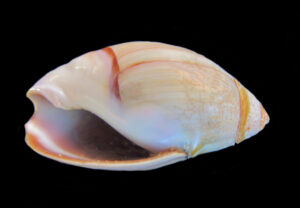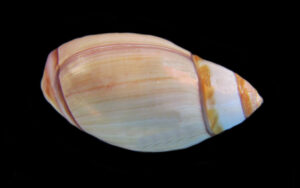Purple Dwarf Olive Shell, Callianax biplicata

 Purple Dwarf Olive Shell, Callianax biplicata. Shell collected off the beach of Bahía Concepción, Baja California Sur, October 2019. Size: 3.2 cm (1.3 inches) x 1.7 cm (0.7 inches). Collection, photograph and identification courtesy of Bob Hillis, Ivins, Utah.
Purple Dwarf Olive Shell, Callianax biplicata. Shell collected off the beach of Bahía Concepción, Baja California Sur, October 2019. Size: 3.2 cm (1.3 inches) x 1.7 cm (0.7 inches). Collection, photograph and identification courtesy of Bob Hillis, Ivins, Utah.
The Purple Dwarf Olive, Callianax biplicata (G.B. Sowerby I, 1825), is a gastropod mollusk that is a member of the Olividae Family of Olives. They are also known as the Two-plated Dwarf Olive. The shell has whorls that are marked with a dark line, a large spire that has a larger spire to body ratio than most Olives, a pointed apex and an aperture that is wider at the bottom than at the top that has an inner lip with two folds. The exterior of the shell is bluish gray, brown or white; the anterior is usually white; the interior is white with purple-gray blotches; and, there is a purple band along the inside edge of the outer lip. The Purple Dwarf Olive Shells reach a maximum of 3.8 cm (1.5 inches) in length and 2.0 cm (0.8 inches) in height.
Purple Dwarf Olives reside on and within clean sand substrate, at the entrance to lagoons and on protected open coast from the intertidal zone to depths up to 50 m (165 feet). They range from Alaska to Magdalena Bay, Baja California Sur. They are not found in the Sea of Cortez. These shells have been found in abundance in archaeological sites ranging from the coast to the Great Basin and the Desert Southwest of the United States. Beads made from these shells have served as currency via many cultures for centuries.